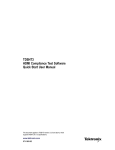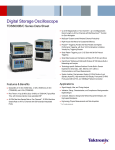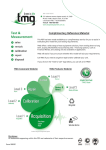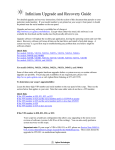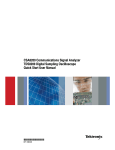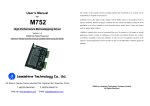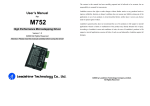Download Probe Bandwidth Calculations
Transcript
Technical Brief Probe Bandwidth Calculations A probe is a critical element in an oscilloscope measurement system. An oscilloscope probe provides the physical and electrical connection to the circuit under test. It also buffers and conditions the signal for the oscilloscope channel input. An ideal oscilloscope probe would measure a signal with perfect fidelity so that it can be accurately displayed on the attached oscilloscope. In making this measurement the probe would also ideally not disturb the probed signal in any way. Since ideal probes are only available in an ideal world, here in the real world probe measurement fidelity is limited by both probe electrical performance and probe loading. Every engineer has a story about a probe causing a circuit to stop working. There are even stories about probes that cause circuits to start working. The reality is that probes interact with the devices under test (DUT), and this interaction modifies the shape of the signal waveform. One of the main goals in probe design is to minimize the probe loading to such a point that the interaction is insignificant to the device under test. Unfortunately as signal speeds increase, it becomes more difficult to reduce probe loading to an insignificant level. Probe Bandwidth Calculations Technical Brief Figure 1. Discrete Model of Probe Loading. Figure 2. Distributed Model of Probe Loading. Historically, oscilloscope probes have been described using discrete models. A typical discrete model, as shown in Figure 1, describes the probe loading as DC resistance and an input capacitance. on the physical properties of the material around the transmission line. For a microstrip transmission line on FR-4 circuit board material, the propagation velocity is about 150 ps/inch, which is about half the speed of light. For a signal rise time of 500 ps, the length of transmission line over which the rise time variation of the signal can be observed is about three inches (electrical length = signal rise time/propagation velocity). A conservative guideline that can be applied is that an interconnect can be expected to show transmission line effects for interconnects longer than 1/6th the length over which the signal variation propagates (0.5 inch for the microstrip transmission line example)*1. As long as the physical characteristics of the circuit are smaller than this 1/6th of a propagation length, a discrete model can be used. However as electrical interconnects get faster, this becomes much more of an issue. A 100 ps rise time signal will have a 0.66 inch propagation length in FR-4. Features larger than 0.11 inches will start to show transmission line effects. This is a valid method when the signal speeds are slow. Electrical signals will propagate down a transmission line with a propagation velocity that depends Oscilloscope probes are now being described with distributed models, as shown in Figure 2. These models help to take into account transmission line effects. Increasing signal speed for digital communications has placed new demands on probe electrical performance and loading. High speed signal probing requires an oscilloscope probe to measure signals in a transmission line environment. The effect of probe loading in a transmission line environment requires a more complex treatment than the simple discrete probe load models once commonly used. Probe loading effects in a distributed circuit environment have also led a probe vendor to introduce a new approach to both probe measurement and probe specification. Because this new approach has created some confusion in the probe market, this paper will examine this new approach and compare it with the more traditional, accepted approach. Probe Loading *1"TekConnect™ Probes: Signal Fidelity Issues and Modeling", Tektronix, Inc. 2 www.tektronix.com/accessories Probe Bandwidth Calculations Technical Brief Probe loading can be more accurately characterized by its input impedance over the frequency range of the probe. Figure 3 shows the input impedance variation with frequency of a high performance differential probe. The use of input impedance is a straightforward way to model complex interactions between resistance, capacitance and inductance over frequency. This characterization method allows probe users to gauge the impact of the probe loading at specific frequencies. Oscilloscope Probing Philosophy Oscilloscope probes have a very different usage model when compared to oscilloscopes. Today’s high bandwidth oscilloscopes all have 50Ω terminations on each channel. The oscilloscope is meant to be used as an end-of-line receiver that expects to see a signal coming from a 50Ω source. An oscilloscope probe is intended to be connected to a device under test that is, presumably, already source and receiver terminated. These probes are usually designed to have a high input impedance so that the probe affects the device under test as little as possible. There are two schools of thought on what an oscilloscope probe should actually display on an oscilloscope. Tektronix subscribes to the philosophy that a probe should measure the unloaded, or original, signal. Agilent subscribes to a different philosophy that says a probe should measure the loaded signal. What exactly does this mean? First you have to understand how probe bandwidth is characterized. The through response, or transfer function, of a probe is characterized as VOUT / VIN where VIN is the input to the probe and the VOUT is the output of the probe. The ratio describes the gain of the probe amplifier and can be written as VOUT (f)/VIN(f) because this gain can change with frequency. The bandwidth of the probe is defined as the frequency at which the transfer function of the probe is down to 0.707 (3dB) of its low frequency Figure 3. Differential Input Impedance of Tektronix P7380 with Short Flex Small Resistor Flex Tip-Clip™ Assembly. value. This is an industry standard definition of bandwidth. The difference in implementation methodology between Tektronix and Agilent concerns the definition of the reference signal, VIN. Introducing the probe into that well controlled environment can cause that environment to change. Tektronix and Agilent account for that change in different ways. Throughout the years, 50Ω environments have been the standard for generation and transmission of high speed signals. Consequently, oscilloscope probes have been generally characterized using a terminated 50Ω signal generator. The response of a test signal generator is calibrated to be as flat as possible over the frequency range of interest. Tektronix characterizes this flat source (VSOURCE) and calls it VIN. The probe response is then designed to be as flat as possible throughout its frequency range in this clean 50Ω environment. This method of characterizing probes has an inherent effect of compensating for the probe loading. A probe of this type displays the original unloaded signal on the oscilloscope. This is the signal the device under test would see before the probe is attached. www.tektronix.com/accessories 3 Probe Bandwidth Calculations Technical Brief Agilent takes the position that the loading of the probe has an impact on the measured signal such that VSOURCE ≠ VIN. They assert that the probe’s frequency dependent loading has to be measured and factored into the calibration to accurately derive the bandwidth of the probe. A probe that has been characterized with this method gives a bandwidth and probe response that includes the loading of the probe in a 50Ω environment. This probe does not attempt to compensate for the loading, but in fact includes the loading. An Agilent probe displays on the oscilloscope screen the original signal as it has been loaded by the probe. If a probe existed that had no loading, both philosophies would converge and you would see no difference between the probes. Since probe loading does exist, the difference in measurement philosophy has an impact on both the waveform displayed by the probe and the specifications of the probe bandwidth. To better explain the difference in philosophies, let us look at a simplified example. Suppose you have a perfect 1VDC signal that you want to measure. When you measure this signal with a probe, you expect the probe to measure 1VDC. If probe loading caused the signal level to drop to 0.95V, would you want the probe to read 1VDC or 0.95VDC? The Tektronix philosophy is that you want to see a 1V signal. Agilent’s philosophy is that you want to see the 0.95V signal. This example can be taken one step further. Suppose you want to measure a perfect AC sinusoidal 1Vpp signal. This signal can be swept from a few hertz to gigahertz frequencies and still have a perfect 1Vpp signal level. As the signal source is swept through its frequency range, should the probe output change with frequency due to its changing load profile or should the output of the probe read 1Vpp throughout the 4 www.tektronix.com/accessories majority of its frequency range? This is a simplified example, but it clearly illustrates the differences in probing philosophy. Tektronix believes that it is more useful for probe users to know what is happening inside their circuits when the probe is not attached. The remainder of this paper examines in greater detail the effect of Agilent’s probing philosophy and why Tektronix supports the traditional bandwidth measurement technique. How Probe Bandwidth is Measured Tektronix designs the probe response to be as flat as possible throughout its frequency range. This flatness is tested with a Network Analyzer that has been calibrated along with a probe test fixture to be a flat source out to 20 GHz, as shown in Figures 4 and 5. Network analyzers typically have special high frequency coaxial connectors, so a special probe calibration test fixture is used to connect the probe to the network analyzer. The network analyzer is then calibrated to take out any frequency effects of the cables and the test fixture. This method insures the repeatability of the measurement because there can be slight differences in cables and fixtures between test stations. This flat system is what Tektronix defines as VSOURCE or VIN. The probe is then connected to the test fixture, as shown in Figure 6, and the response of the probe is measured, as shown in Figure 7. Probes have components that can be used to adjust their frequency response. These components can be actively adjusted to calibrate the probe in real time and make the response as flat as possible throughout its frequency range. One advantage of this method is that the frequency dependant loading of the probe is automatically compensated in the process. Probe Bandwidth Calculations Technical Brief Probe Test Fixture Figure 4. Network analyzer and test fixture setup for test system calibration. Probe Figure 5. After calibration, network analyzer showing a flat Vsource. Probe Power Supply Probe Test Fixture 50Ω Termination Figure 6. Setup for measuring the probe response on the Figure 7. Tektronix P7380 Probe Response. network analyzer. www.tektronix.com/accessories 5 Probe Bandwidth Calculations Technical Brief Probe Test Fixture Figure 8. Calibration Setup to measure probe loading. Figure 9. Loading of Agilent 1134A with Differential Solder Probe Tip. Agilent follows a somewhat similar method, but uses a few additional steps to calibrate the probe to show a loaded response. After the network analyzer has been calibrated as a flat source with the test fixture, the probe loading over frequency is measured and saved to memory. This is done by measuring the test fixture through response with the probe connected to the test fixture, as shown in Figure 8. The result of the probe loading on the test fixture through response is shown in Figure 9. Math is then used to divide the flat reference by the probe loading to account for the affects of loading. This is what Agilent uses as VIN when they do the bandwidth calculation. Then the probe is placed into the system and its frequency response is measured. Figure 11 shows the Agilent probe response using the traditional bandwidth measurement used by Tektronix. Figure 12 shows the Agilent probe response using the new Agilent bandwidth measurement method. It can be seen by comparing the two figures that the new Agilent bandwidth method tends to inflate the probe bandwidth compared to the traditional method. 6 www.tektronix.com/accessories Figure 10. Calculated VIN using math to account for probe loading. Probe Bandwidth Calculations Technical Brief Figure 11. 1134A Differential Solder Probe Tip Response without using math to divide out the loading (Tektronix Method). If the probe is measured using the Tektronix method, the probe response exhibits about a 2dB roll-off starting around 2 GHz. Once the loading is divided from the probe response, the probe looks fairly flat throughout its frequency range. The Agilent probes are designed to give a math frequency response, or loaded response, that is as flat as possible. The bandwidth of the probe is then defined as the point where this math response is down 3dB from the probe’s DC response. In essence the new Agilent bandwidth specification method assumes a zero ohm source impedance, a source unaffected by probe loading. A probe characterized by Agilent’s method would have an effective bandwidth that is lower than its calculated bandwidth because the probe is used in real world environment with real impedances that are not zero. The Tektronix bandwidth measurement method by comparison is optimized for an effective 25Ω source impedance (50Ω source in parallel with a 50Ω termination), which is much closer to real world conditions for measuring high speed signals in a terminated 50Ω environment. Figure 12. 1134A Differential Solder Probe Tip Response using math to divide out the loading (Agilent Method). One indication of the limitations of this new Agilent method for specifying probe bandwidth is to consider the case of a probe with a high bandwidth and a large amount of probe loading. This probe, using the Agilent bandwidth measurement method, would appear to have a very high bandwidth, but would have limited usefulness in a real world environment. Time Domain Response - Ramifications of Using a Loaded Response Probe Although one of the main specifications for oscilloscopes is bandwidth, a measure of frequency response, oscilloscopes are primarily time-domain instruments. The data displayed on an oscilloscope is a graph of amplitude versus time. Differences that look small in the frequency domain can have a big impact in the time domain. www.tektronix.com/accessories 7 Probe Bandwidth Calculations Technical Brief Unloaded Eye Pattern from Source* Figure 13. Time Domain effect of probe loading as shown on the CSA/TDS8000 sampling oscilloscope. *2.5 Gb/s PRBS7 data pattern, 40 ps 10/90% Rise time A square wave is much more complex than it looks when seen on an oscilloscope display. According to Fourier math, a perfect square wave can be broken down into an infinite series of harmonic sinusoids. However, since today’s probes and oscilloscopes do not have an infinite amount of bandwidth, a square wave signal will not appear perfect. Since the square wave signals cannot change instantly from a low state to a high state, rise time and fall time numbers are used to characterize the speed of this change. More high frequency content equates to faster rise and fall times. The sharpness of the square wave signal edges is affected by the amount of high frequency content that is available. Probe loading is frequency dependant and it typically gets worse at higher frequencies. Therefore probe loading has a direct impact on the corner of any step function or square wave. Figure 13 illustrates the probe loading affects on an eye diagram. The differences between the two philosophies of showing either the unloaded response (Tektronix) or the loaded response (Agilent) become much more apparent in the time domain. 8 Loaded Eye Pattern www.tektronix.com/accessories How the Theory is Reduced to Practice As shown in Figures 14 and 15, both measurement methodologies produce what they promise. The Tektronix probe was designed to show the original signal that was output by the device under test before the probe was attached. Even for a signal with this fast rise time, the response shown on the oscilloscope display looks very similar to the eye diagram generated by the source. The Agilent probe was designed to show the loaded signal, the signal in the device under test after the probe was attached. The response on the Agilent oscilloscope display does have similar features to the loaded eye pattern. Both methods for calibrating the probes are valid, depending on what you want to look at and measure. Tektronix believes that most probe users want to know what is happening inside their circuits when a probe is not attached. Therefore the probes are designed to meet that need. If you want to know what is happening inside the circuit, you should choose a Tektronix probe. This type of probe is a good general purpose tool for making measurements without a lot of effort. Probe Bandwidth Calculations Technical Brief Tektronix P7380 Probe Response on TDS6804B Oscilloscope Unloaded Eye Pattern from Source* Loaded Eye Pattern Figure 14. Example of an unloaded response type probe in the time domain. *2.5 Gbps PRBS7 data pattern, 40 ps 10/90% Rise time Agilent 1134A Differential Probe Tip Response on 54855A Oscilloscope Unloaded Eye Pattern from Source* Loaded Eye Pattern Figure 15. Example of a loaded response type probe in the time domain. *2.5 Gbps PRBS7 data pattern, 40 ps 10/90% Rise time www.tektronix.com/accessories 9 Probe Bandwidth Calculations Technical Brief If you want to see how the probe is affecting your circuit, you should consider choosing an Agilent probe. For example, this is useful if the circuit can be modeled and simulated. The probe loading can be added to the model and the output of the simulation can be checked with the output of probe and oscilloscope. A Tektronix probe can be used for this type of measurement, but it requires that the device under test be terminated into an oscilloscope channel, typically through a coax cable. This type of connection is not always available on circuit boards. An Agilent probe is good in a few specific applications, but it does not work very well as a general purpose tool. The probe will not give you the data you are looking for without a lot of auxiliary calculation and extra time because the loading of the probe is always included in the data. This type of probe is not a good general purpose tool because it adds an extra layer of complexity. Engineers know what they expect to see when they measure their circuits and they use probes to verify that everything is working as designed. The Agilent probe will only show the system performance as it is affected by the probe loading. Engineers then have to decide if what they are seeing is due to their system or just part of the effect of probe loading. It is possible to take the data and work backwards to find the original signal, but this process is difficult and time consuming. Agilent has no automated oscilloscope routine that will perform this step. It must be done for every single waveform that is measured. If this step is omitted, then the data that is recorded is suspect. This phenomenon can become even more of a issue if engineers want to use one of the vast array of applications that are available on oscilloscopes. 10 www.tektronix.com/accessories All of theses applications use the oscilloscope data to perform their analysis. If the raw probe data is used, the applications may give false passes or fails because of the extra effects from the probe that are not there in the original signal. Agilent has an application note that describes in more detail methods that can be used to take the output of their probe and work backwards to display the original signal. Agilent sampling oscilloscopes have a normalization feature that can be used to calibrate out test fixture features when making time-domain reflectometer (TDR) measurements. This same normalization feature can be used to account for the probe loading and helps the probe display the original signal. The drawback to this method is that the source needs to be well characterized with the probe loading in place before the normalization can occur. In many instances, the probe user’s final goal is to characterize their own signal. Why go through all the trouble to fully characterize their signal so that they can go back and measure it again with the probe? Agilent’s real time oscilloscopes do not have this normalization feature. Their solution to this problem is to add a probe compensation circuit to the source using discrete components. While this does produce the desired effect, it is an impractical solution for engineers testing their own circuits. Why go through all the trouble to back out the original signal from the Agilent probe when a Tektronix probe does this directly? Another drawback of an Agilent probe is that it cannot be reliably used for mask testing. As can be seen in the pictures, probe loading can have a significant impact on the front corner of high speed digital signals. This could cause a signal to artificially fail or pass a mask test because the probe loading is part of the response. Probe Bandwidth Calculations Technical Brief Mask testing is an important tool for high speed serial data testing. Most serial data standards specify masks that may be used to validate data streams to make sure they comply to the standards. The masks are typically designed to be used with an end-of-line receiver, like a terminated 50Ω oscilloscope channel or an SMA-input probe like the P7380SMA. End-of-line receivers do not have to deal with the issues of probe loading. The signal quality that reaches the receiver depends mainly on the quality of the transmission lines and the 50Ω termination. The masks define the limits of a serial data stream in its intended environment, which does not include external factors like probe loading. Sometimes it is not possible to gain access to a serial data stream to pipe it directly into an oscilloscope. An example of this situation would be two chips on the same board that have a high speed serial connection between them. The only way to gain access to the data stream would be to use an oscilloscope probe. A Tektronix probe can be used for mask testing because the probe is designed to reproduce the signal as it was in its original environment. On the other hand, an Agilent probe displays a signal that includes the probe loading and may not meet the criteria to make a valid mask test. A circuit that is designed to pass a mask test with an Agilent probe may experience problems when the probe is not connected to the system, because it passed the test in a non-valid environment. An Agilent probe may be used to make compliance tests if special modified masks are used, but standard masks as specified by the standard committees cannot be used. The Agilent probe’s rise time measurements may also be invalid because the probe’s loading affects the front corner of any step response. The probe response that is displayed on the oscilloscope screen includes the loading. Oscilloscope measurement algorithms are typically designed to look for a 10-90% point to make its measurement. Distortion in the front corner may change the wave shape enough that the 90% point is significantly different and measures incorrectly. 20-80% rise time measurements experience less of an impact from front corner distortions because the measurement takes place farther from the corner. Conclusion An oscilloscope probe is a tool used by engineers to quickly make measurements and help get products to market. The enormous increase in signal speeds over the past few years has introduced complexities in probing that probe users need to know about and account for. In the past, all oscilloscope probe designers subscribed to the same philosophy. The introduction of Agilent’s loaded response type probe has given probe users an extra tool, but it has also caused some confusion. Care must be taken to understand how a probe will interact with a DUT, no matter which probe type is used. Agilent probes might be good tools for a small set of applications, but are not well suited for general purpose probing tasks like DUT characterization, validation, and mask testing because they require extra calculation to extract the probe loading. In contrast, Tektronix probes are good tools for general purpose probing tasks because they endeavor to directly show the original, unloaded signal. www.tektronix.com/accessories 11 Sources: "Z-Active™: A New High Performance Probe Architecture", Tektronix, Inc. Contact Tektronix: ASEAN / Australasia / Pakistan (65) 6356 3900 Austria +41 52 675 3777 Balkan, Israel, South Africa and other ISE Countries +41 52 675 3777 "ABC's of Probes", Tektronix, Inc. Belgium 07 81 60166 Brazil & South America 55 (11) 3741-8360 Canada 1 (800) 661-5625 "Side-by-Side Comparison of Agilent and Tektronix Probing Measurements on High-Speed Signals", Agilent App Note 1491 Agilent Technologies, Inc. Central Europe & Greece +41 52 675 3777 Central East Europe, Ukraine and Baltics +41 52 675 3777 Denmark 80 88 1401 Finland +41 52 675 3777 "Time-Domain Response of Agilent InfiniiMax Probes and 54850 Series Infiniium Oscilloscopes", Agilent App Note 1461 Agilent Technologies, Inc. France & North Africa +33 (0) 1 69 81 81 Germany +49 (221) 94 77 400 Hong Kong (852) 2585-6688 India (91) 80-22275577 Italy +39 (02) 25086 1 User Manual: 1134A 7 GHz InfiniiMax Differential and Single-ended Probes (Publication Number 01134-97007), Agilent Technologies, Inc. Japan 81 (3) 6714-3010 Luxembourg +44 (0) 1344 392400 Mexico, Central America & Caribbean 52 (55) 56666-333 Middle East, Asia and North Africa +41 52 675 3777 The Netherlands 090 02 021797 Norway 800 16098 People’s Republic of China 86 (10) 6235 1230 Poland +41 52 675 3777 Portugal 80 08 12370 Republic of Korea 82 (2) 528-5299 Russia, CIS & The Baltics 7 095 775 1064 South Africa +27 11 254 8360 Spain (+34) 901 988 054 Sweden 020 08 80371 Switzerland +41 52 675 3777 Taiwan 886 (2) 2722-9622 United Kingdom & Eire +44 (0) 1344 392400 USA 1 (800) 426-2200 USA (Export Sales) 1 (503) 627-1916 For other areas contact Tektronix, Inc. at: 1 (503) 627-7111 Updated November 3, 2004 For Further Information Tektronix maintains a comprehensive, constantly expanding collection of application notes, technical briefs and other resources to help engineers working on the cutting edge of technology. Please visit www.tektronix.com Copyright © 2004, Tektronix, Inc. All rights reserved. Tektronix products are covered by U.S. and foreign patents, issued and pending. Information in this publication supersedes that in all previously published material. Specification and price change privileges reserved. TEKTRONIX and TEK are registered trademarks of Tektronix, Inc. All other trade names referenced are the service marks, trademarks or registered trademarks of their respective companies. 11/04 FLG/WOW 60W-18324-0













